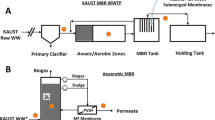Abstract
A new membrane filter technique for field use was developed for the enumeration of either aerobic or anaerobic, autotrophic, sulfur-oxidizing bacteria in waters and soils. Immediately after collection, samples were filtered through sulfur-coated filters and incubated in selective media. Acidification or gas evolution was used as a growth indicator of aerobic and anaerobic thiobacilli, respectively, and related to the initial number of cells deposited on the filter.
Similar content being viewed by others
References
Augier, J. 1956. A propos de la numération des Azotobacter en milieu liquide,Ann. Inst. Pasteur 91, 759–765.
Baalsrud, K. and Baalsrud, K.S. 1954. Studies onThiobacillus Denitrificans, Arch. Mikrobiol. 20, 34–62.
Baas-Becking, L.G.M. and Wood, F.E.J. 1955. Biological processes in estuarine environment. I: Ecology of the sulphur cycle,Proc. K. Ned. Akad. Wet. 58: 160–181.
Baldensperger, J. and Garcia, J.L. 1975. Reduction of oxidized inorganic nitrogen componds by a new strain ofThiobacillus denitrificans, Arch. Microbiol. 103: 31–36.
Baldensperger, J. Guarraia, L.J. and Humphreys, W.J. 1974. Scanning electron microscopy of thiobacilli grown on colloidal sulfur.Arch. Microbiol. 99:323–329.
Buchanan, R.E. and Gibbons, N.E. 1974.Bergey's Manual of Determinative Bacteriology (eighth ed) Williams and Wilkins, Baltimore.
Cook, T.M. 1964. Growth ofThiobacillus thiooxidans in shaken cultures,J. Bacteriol. 88: 620–623.
Freney, J.R. 1967. Oxidation of sulphur in soils,Miner. Deposita 2: 181–187.
Hart, M.G.R. 1959. Sulphur oxidation in tidal mangrove soils of Sierra Leone,Plant Soil 11: 215–236.
Hattori, T. 1974.Microbial Life in the Soil, An Introduction. Marcel Dekker, New York.
Hutchinson, M., Johnstone, K.I. and White, D. 1969. Taxonomy of the genusThiobacillus: the outcome of numerical taxonomy applied to the group as a whole,J. Gen. Microbiol. 57: 397–410.
Kodama, A. and Mori, T. 1968. Studies on the metabolism of a sulfur oxidizing bacterium. V. Comparative studies on sulfur and sulfite oxidizing systems ofThiobacillus thiooxidans, Plant Cell Physiol. 9: 725–734.
LaRivière, J.W.M. 1966. The microbial sulfur cycle and some of its implications for the geochemistry of sulfur isotopes,Geol. Rundschau 55: 568–582.
Moser, U.S. and Olson, R.V. 1953. Sulfur oxidation in four soils as influenced by soil moisture tension and sulfur bacteria,Soil Sci. 76: 251–257.
Mouraret, M. 1971. Etude biologique des eaux du barrage d'Ayame I en Côte d'Ivoire. Convention report ORSTOM-EECI, ORSTOM, Paris.
Mouraret, M. 1972. Etude biologique des eaux dans quelques cours d'eau du Cameroun et du Gabon. Convention report ORSTOM-S.N.E.C.-S.E.E.G. ORSTOM, Paris.
Pochon, J. and Tardieux, P. 1962.Techniques d'analyse en microbiologie du sol. Editions La Tourelle, Saint-Mondé France.
Postgate, J.R. 1966. Media for sulphur bacteria,Lab. Pract. 15: 1239–1244.
Spurny, M., Dostalek, M. and Ulehla, J. 1957. A method of quantitative determination of sulphate reducing bacteria,Folia Biol. (Praha) 3: 202–211.
Starkey, R.L. 1950. Relations of microorganisms to transformations of sulfur in soils,Soil Sci. 70: 55–65.
Starkey, R.L. 1966. Oxidation and reduction of sulfur compounds in soils,Soil Sc. 101: 297–306.
Stotzky, G. and Rem, L.T. 1966. Influence of clay minerals on microorganisms. I. Montmorillonite and kaolinite on bacteria,Can. J. Microbiol. 12: 547–563.
Taylor, B.F. 1968. Oxidation of elemental sulfur by an enzyme system fromThiobacillus neapolitanus, Biochim. Biophys. Acta 170: 112–122.
Tilton, R.C., Cobet, A.B. and Jones, O.E. 1967. Marine Thiobacilli. I. Isolation and distribution,Can. J. Microbiol 13: 1521–1528.
Tuovinen, O.H. and Kelly, D.P. 1973. Studies on the growth ofThiobacillus ferrooxidans. I. Use of Membrane filters and ferrous iron agar to determine viable numbers, and comparison with14CO2 fixation and iron oxidation as measures of growth,Arch. Mikrobiol. 88: 285–298.
Tuovinen, O.H., Niemelä, S.I. and Gyllenberg, H.G. 1971. Tolerance ofThiobacillus ferrooxidans to some metals.Antonie van Leeuwenhoek 37: 489–496.
Vishniac, W. and Santer, M. 1957. The Thiobacilli.Bacteriol. Rev. 21: 195–213.
Author information
Authors and Affiliations
Rights and permissions
About this article
Cite this article
Mouraret, M., Baldensperger, J. Use of membrane filters for the enumeration of autotrophic thiobacilli. Microb Ecol 3, 345–358 (1977). https://doi.org/10.1007/BF02010741
Issue Date:
DOI: https://doi.org/10.1007/BF02010741



